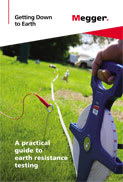Ground Clamp Meters
The Clamp-on Ground Resistance testing technique offers the ability to measure the resistance without disconnecting the bonding to ground. This type of measurement also offers the advantage of including the bonding to ground and the overall grounding connection resistances. Grounding instrumentation is chosen based on requirements, applications and safety considerations.
Here is a list of several Ground Testing Applications
- Soil Resistivity- 4 Point Tester
- Ground Resistance Rods- 3 Point Tester
- Low Ground Resistance Grids or Mats or Plates- 3 or 4 Point Tester
- Ground Resistance for Multiple Grounds without disconnecting system- Clamp-On Tester
- Step and Touch Potential- 4 Point Tester
- Continuity on Bonding or Grounding -2 or 4 Point Tester
- Earth Coupling- 3 Point Tester
A grounding system is designed to provide safety for a variety of conditions that may exist
- Lightening strikes to protect personnel or system components
- Electrical faults
- Static Electricity Problems
- Voltage Regulations for Safety
A good grounding system will improve the reliability of equipment and reduce the likelihood of damage due to lightning or fault currents. The primary reason that grounding is tested is the fact that resistance to an earth ground rod or system may vary based on changes in climate and temperature and over time. Such changes can be considerable. Over time, corrosion will degrade ground rods and their connections. It is reasonable to consider an annual maintenance program that checks grounds and bonding.
Features to consider when evaluating your selection for Ground Testers
- Types of Ground Testing to be Evaluated
- Number of Poles (points) for tests to be completed
- Display Required
- Graphics Required
- Memory Required and Capacity
- Enclosure IP Ratings
- Wiring Spools and Additional Rods Needed
- Wiring Capable of Being Disconnected for Portable Clamp-On
- Rechargeable Battery or Field Battery Supply
- Test Current
- Safety Rating
- Resolution
Traditional types of methods for ground testing include
- Three Point Fall of Potential for Ground Rods and Grids.
- Four Point Soil Resistivity Testing
- Touch Potential for Electrical Safety (high ground fault possibility)
- Two-Point Tests (continuity tests and bonds)
- Clamp-On, discussed here
Portable Clamp-On Method for Ground Testing
Clamp-on ground resistance testing offers the ability to measure the ground resistance without disconnecting the ground rods or the wiring of the system. This type of measurement also offers the advantage of including the bonding to ground and the overall grounding connection resistances. One of the most important considerations for the portable clamp-on system would be a series-parallel resistance path down-stream from the measurement point that is lower in resistance than the point being measured. Please note figures below for typical Clamp-on placement for measurement.
Applications for Clamp-on Ground Resistance Testers
- Measure electrical ground rod and grid resistance
- Use on multi-grounded systems without disconnecting the ground rod under test
- Measure resistance and continuity of grounding loops around pads and buildings
- Measure leakage current flowing to ground or circulating in ground systems
- Conduct field surveys
- Use on cell towers and telecommunication sites
- Use on pools, spas and other consumer installations
For a discussion of the other methods of ground resistance measurement,
see our main category Products > Ground Testers
Ground Testing Resources
These links can be used as excellent references for basic Ground Resistance theory. Click the cover to download the PDF
 |
![AEMC Ground Resistance Testing]() |
![Fluke Earth Ground Resistance Testers]() |
Megger
Getting Down to Earth |
AEMC
Ground Resistance Testing |
Fluke
Earth Ground Resistance Testers |